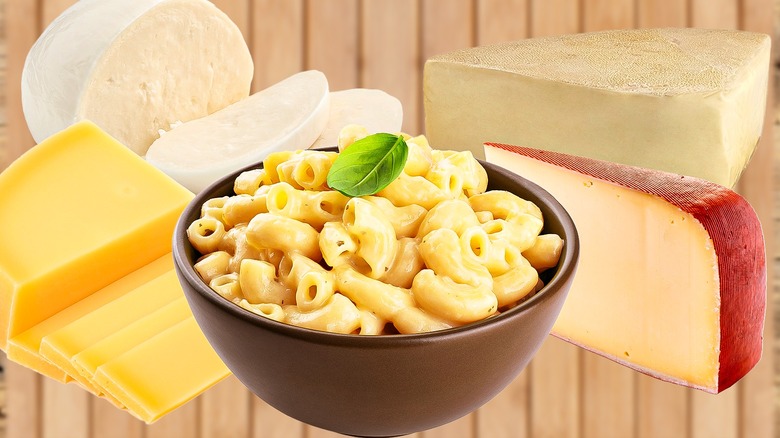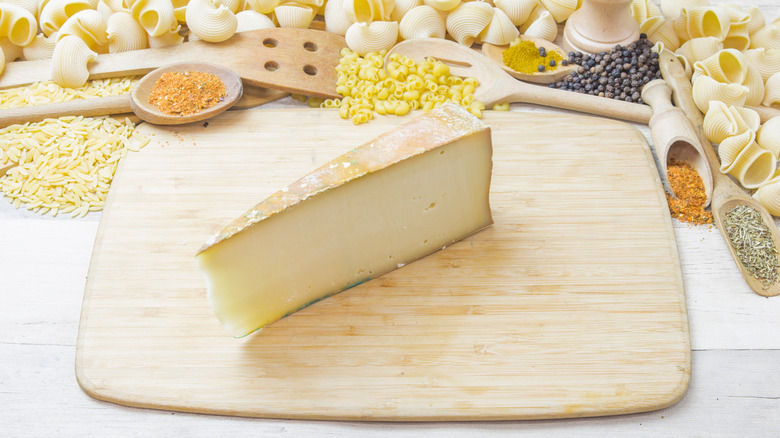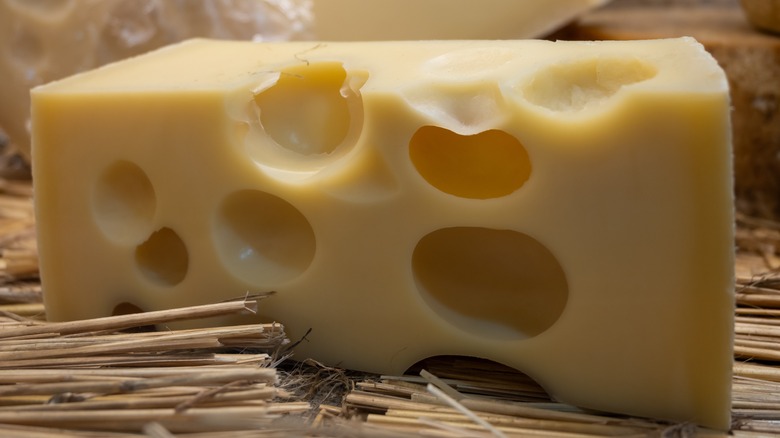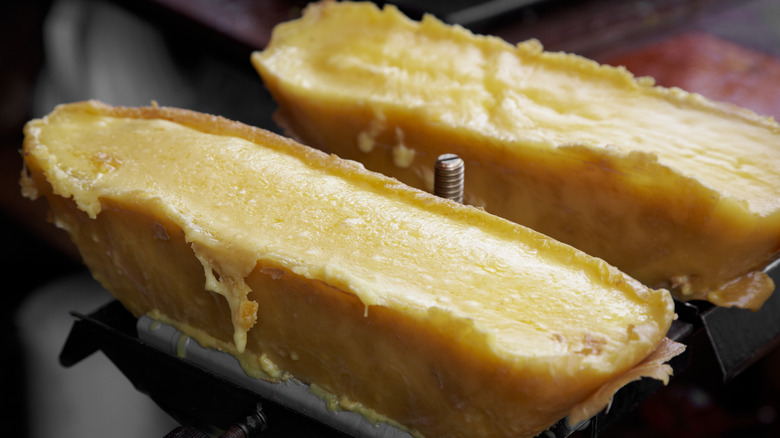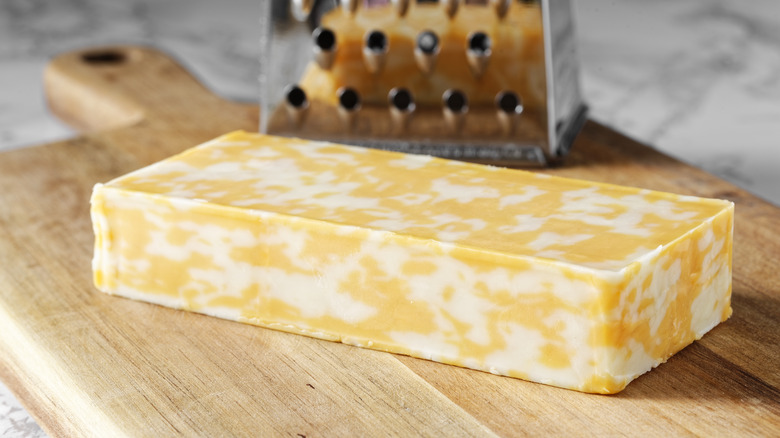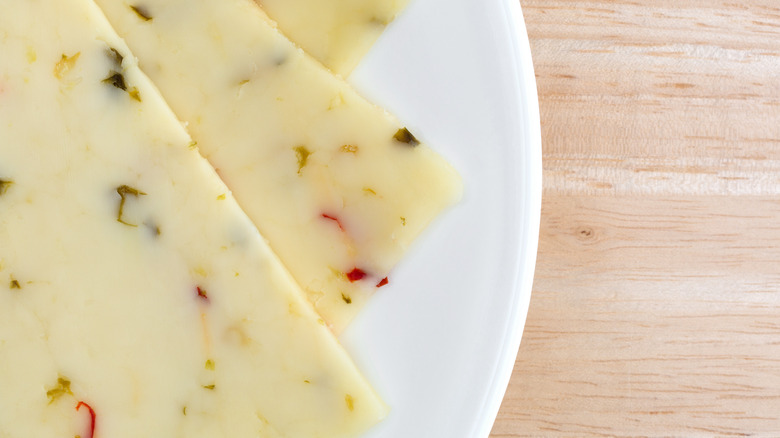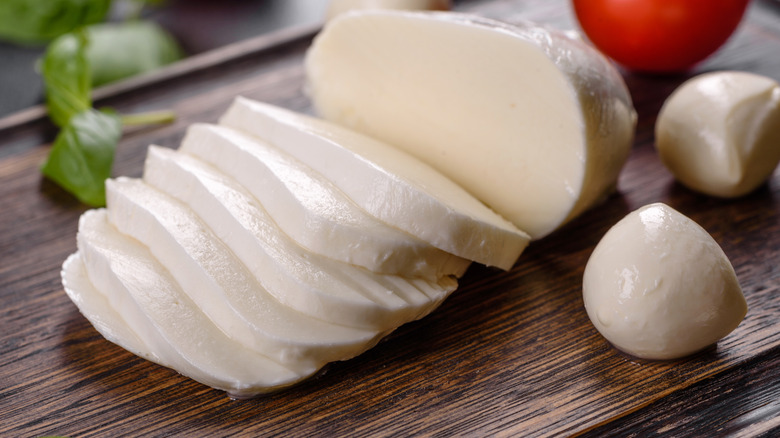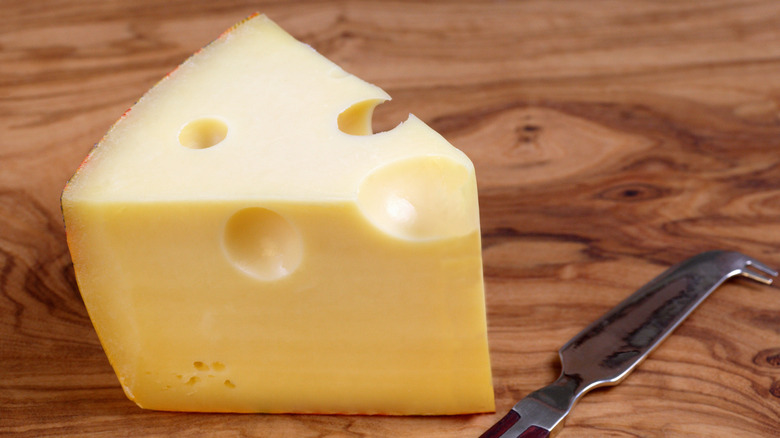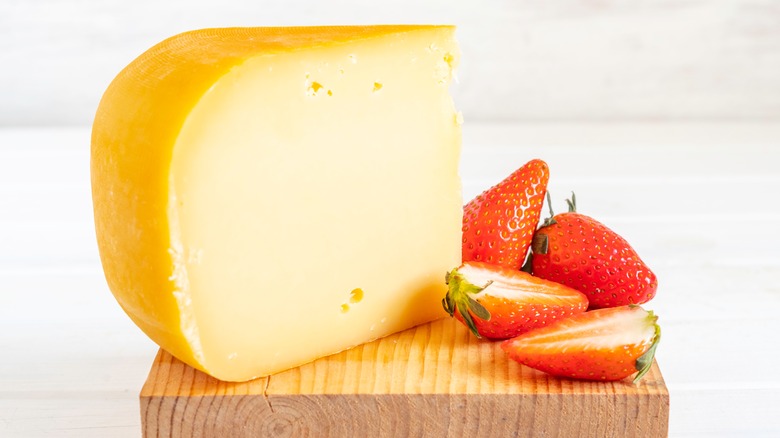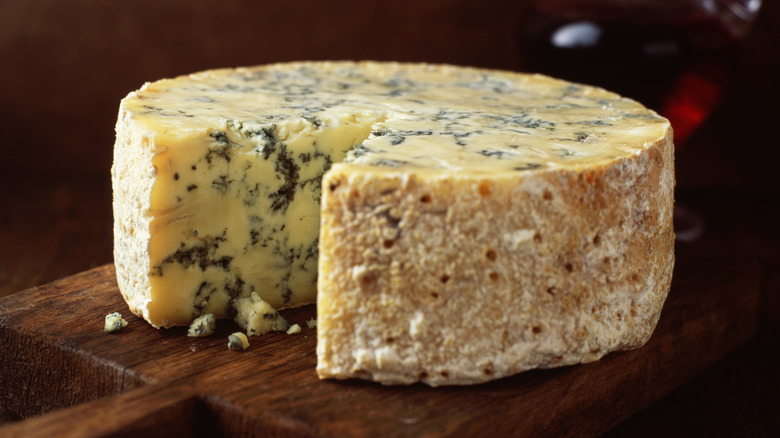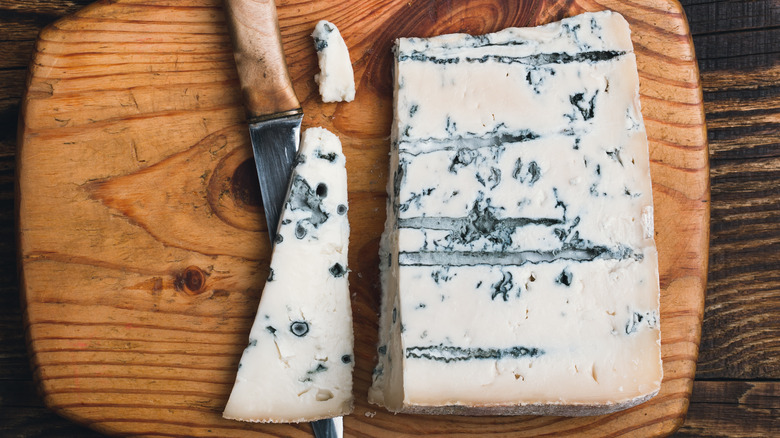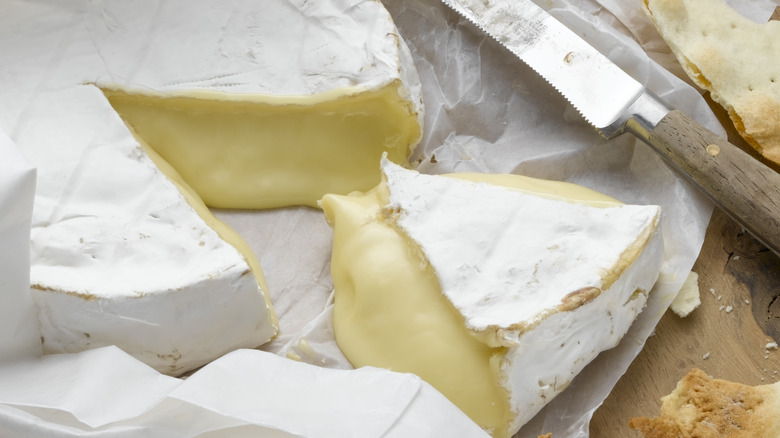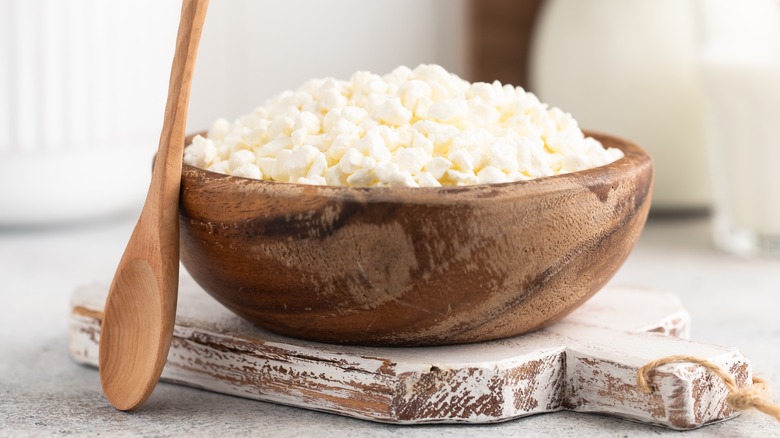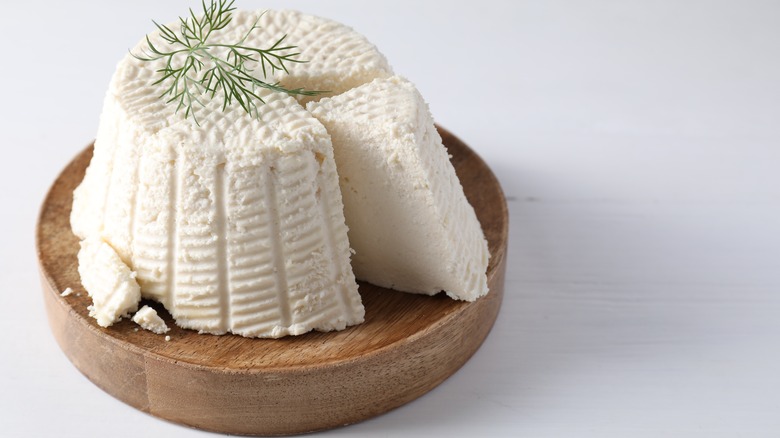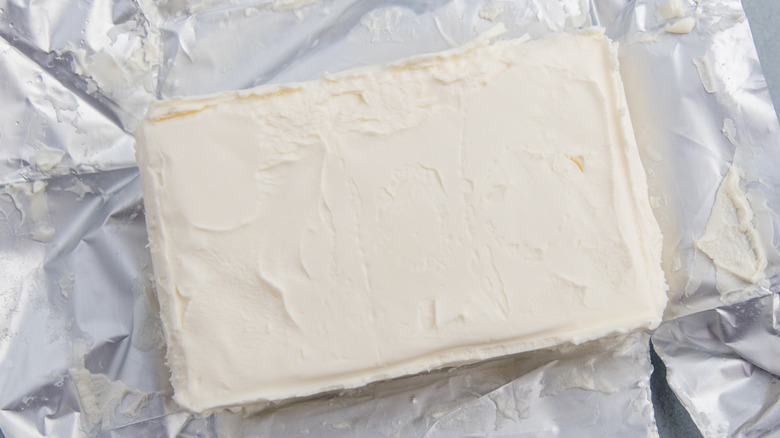14 Underrated Cheeses You Should Mix Into Your Classic Mac And Cheese
Macaroni and cheese may be the ultimate comfort food, but mixing in extra or different cheeses can take this universally loved favorite to the next level. The dish may have started to highlight parmesan cheese and evolved with classic cheddar as a main ingredient, but there are numerous unexpected cheeses to try as well.
Great macaroni and cheese is rich and gooey, with cheese that melts around every delicious noodley bite. For this reason, it's not surprising that many of our top recommendations include options like swiss, mozzarella, and cream cheese. Others bring a boost of flavor, such as spicy pepper jack and stinky blue cheese. No matter what type you choose, consider if you want that taste to take center stage or prefer it to meld with other rich cheeses as well. You can use them on their own or in combination with each other to create the ultimate mac and cheese. Mac and cheese is also the perfect way to try out new add-ins and flavor combinations, so don't hesitate to be adventurous with this classic dish.
Fontina
With a nutty flavor profile, fontina adds a boost of rich savoriness to your mac and cheese. Fontina is made with cow's milk and has a flavor similar to other cheese made in the Alps, although the most authentic fontina is specific to a region in Italy, where it has been made since the 1300s. Today, it's made in countries around the world using the same process and each region's cheese has a slightly different taste. Fontina has a high fat content, around 45%, which is what makes it so creamy and perfect for mac and cheese.
It works well with add-ins like vegetables and meat as well. Jessica Sennett, CEO of Cheese Grotto, recommends alpine cheeses as an unexpected yet delicious flavor in mac and cheese. "Natural-occurring flavor profiles in these cheeses are savory like cured meat, earthy like mushrooms, and nutty like roasted peanuts," she says. Any of these make a delicious choice that works well with the taste of fontina.
Emmentaler
Originating in the Emme Valley in Switzerland, Emmentaler cheese is another Swiss cheese made with raw cow's milk and aged for at least 18 months. It has the characteristic eyes that form when certain bacteria used to make the cheese creates carbon dioxide, plus a strong natural flavor, thanks to the specific bacteria as well as the aging process. Emmentaler adds earthiness to your mac and cheese, giving it a more complex taste than simple cheddar would on its own. You can add Emmentaler on its own to the dish because it melts well, or pair it with other cheese to create a four-cheese variety.
"Alpine cheeses like Gruyere, Emmentaler, Raclette, and Fontina are excellent melting cheeses that bring an umami, nutty characteristic to a mac and cheese," says Jessica Sennett. This cheese can also have fruit notes, a complex taste that is imparted to your mac and cheese when you mix it in.
Raclette
Perfect for melting, raclette adds rich flavor to mac and cheese. Aged for three to four months, it is a type of Swiss cheese and made with cow's milk. The cows eat a diet of grass in the warm summer months and hay in the colder winter months, which is crucial to get the aromatic flavor of true raclette. It melts particularly well and is often heated and scraped directly onto food, where it adds a rich flavor and creamy consistency.
Jessica Sennett notes that raclette along with other alpine types of cheeses are known for being "dynamic melting cheese that brings extra flavor without additives." This cheese is so great at melting that you can find a special raclette grill to heat it to perfection before letting it ooze over your dish. You can also slice, cube, or shred it and mix the cheese in with macaroni, if you prefer.
Monterey Jack
With a slightly sweet and mild flavor profile, Monterey jack is a good cheese for those who don't want anything too overpowering. Monterey jack is made with pasteurized cow's milk and was first created in Monterey, California, where it gets part of its name. It pairs well with add-ins like spicy jalapeños, salty bacon, and other ingredients that can take center stage thanks to the mild, buttery flavor from the cheese.
"While it can be used on its own it is delicious mixed with other cheeses. It blends well with pepper jack cheese to offer a balance of sweet and spicy," says Angela Latimer, founder, food blogger, recipe developer, food photographer of Bake It With Love. "You can even add fresh jalapeños to a Monterey jack mac and cheese to really bring out the contrasting flavors." You can try just about anything with Monterey jack, including stronger cheeses.
Pepper Jack
For something with some extra kick, mix in some pepper jack cheese. You can use it on its own for the strongest peppery spice or temper it with a milder cheese like Monterey jack or colby jack for a good combination. Pepper jack is made like Monterey jack but has small bits of peppers mixed in with the curds, which only intensify as the cheese ages. Habañero, serrano, and jalapeño peppers are all used, and each cheesemaker and brand has their own unique blend.
"While pepper jack is not too spicy for most people, it does have a strong flavor that can be overpowering in large quantities," says Angela Latimer, who recommends using small amounts for mac and cheese. "The best choice for pepper jack is to balance it out with Monterey Jack, white cheddar, or even mozzarella." Pairing with a milder cheese will keep the peppery taste at the front of the flavor profile but still tame it enough to be enjoyable for a large gathering.
Mozzarella
To make your mac and cheese extra creamy, add mozzarella. It was originally made with buffalo milk and stretched by hand to form balls of cheese. Today, it can be made with buffalo milk following traditional practices or cow's milk. Mozzarella has a mild flavor so you may want to combine it with a sharper cheese for the ultimate in delicious taste and gooey texture. You can mix mozzarella into the macaroni and cheese or sprinkle it on top, then put your dish under the broiler to get a crispy crust.
"Pizza lovers already know that mozzarella melts well," says Angela Latimer. "Therefore, it is a great option for creamy macaroni and cheese." Latimer generally recommends grating your own cheese for the best results, but if you're short on time, getting preshredded cheese is a shortcut that still works well with mozzarella because it melts so well. You can pair mozzarella with a variety of ingredients but it is a classic with tomatoes and pepperoni in tasty pizza mac.
Latimer also calls out a spicier combo that adds some kick to mild mozzarella. "When I pair mozzarella cheese with pepper jack and I don't have more fresh jalapeño or serrano peppers in the garden, I love the flavor of pickled jalapeño slices too," she says. "Finely chopped, they're ideal with this cheese combo." Try pickled jalapeños or other pickled peppers to add both spicy and tang.
Gruyère
Even the name sounds special and when you mix in gruyere to your mac and cheese, it instantly elevates the dish. Gruyère is made with cow's milk and gets its complex flavor from the natural landscape, where cows are able to eat a diet of native grasses and flowers. Unheated milk is used to make the cheese, which ages for anywhere from four to 18 months to develop the signature taste of Gruyère. It has a slightly nutty flavor and melts really well, two elements that make it great for grown up mac and cheese.
"Due to its balance of gooey goodness and rich flavors, many restaurants use gruyere as their cheese of choice for fancy mac & cheese," says Angela Latimer. "Top it with bacon crumbles and a crunchy bread topping for a restaurant-quality meal at home." Gruyère is another alpine cheese, which Jessica Sennett also recommends for its ability to melt well, a key texture required for the best mac and cheese.
Latimer likens Gruyère to another favorite, edam cheese, which has a similar flavor. "Edam cheese is wonderful for melting and is great in macaroni and cheese when combined with other cheeses." She recommends it with Gruyère and sharp cheddar for what she calls "the best mac ever."
Smoked gouda
Another cheese to upgrade this classic comfort food is smoked gouda. Traditional gouda is made from cow's milk in the Netherlands, where it was developed around the late 12th century. Gouda is sweet, especially compared to other sharp and salty cheeses, which gives it a unique taste. Smoked gouda adds an extra layer to the flavor profile thanks to the hickory chips used in the smoking process. This smokiness makes the flavor much more complex and it adds depth to a simple dish like mac and cheese.
"Smoked Gouda may not be the cheese you choose for a family meal with the kids," says Angela Latimer. "But it is the perfect option for a sophisticated take on a simple dish." Different brands and cheesemakers have variations on the process, which can impart different flavors. The constant is the balance of sweet and smokey, plus a creamy feel. Gouda can also develop small crystals within the cheese, which makes the texture even more unique.
Blue cheese
If you like strong, full-bodied cheeses, blue cheese is one to check out. It's made by introducing specific mold spores to cheese curds and allowing oxygen to reach it as it ages to keep the mold growing. This is one of the strongest cheese flavors you can add to your mac and cheese, so use a light hand when mixing it in to start, and customize it to suit your preferences. It also works well when you include a small amount with another milder cheese, such as Monterey jack or cheddar, as a base.
"Don't skip over the stinky cheeses!" says Angela Latimer. "Now, you don't want to make an entire dish that is only blue cheese, that would be way too much. A little bit of blue cheese though? Delicious!" She recommends using other cheeses as the base with blue cheese as an extra addition to tone down the intense flavor. "Try adding just a bit of crumbled blue cheese on top of a mild four-cheese macaroni for a blend of amazing flavors," says Latimer.
Gorgonzola
If you want to experiment with stinky cheeses without jumping all the way to strong blue cheese, gorgonzola is a good alternative. It is a type of blue cheese but noted for its creamier texture and slightly milder flavor, thanks to fewer mold sections in the cheese, than other varieties of blue cheese. Make no mistake, though, gorgonzola is still a full-bodied stinky cheese that will give your macaroni a distinctly earthy flavor. For something less intense, it makes a good addition to mac and cheese with parmesan, as well as mild mozzarella. Gorgonzola also crumbles cleanly, making it easy to add on top of your dish before popping it in the oven to melt. The taste and texture can vary depending on how long the cheese is aged, so no two gorgonzolas are exactly alike.
"If you are not a blue cheese fan but want to explore adding some richness to your macaroni & cheese add a little gorgonzola in," says Angela Latimer. "This cheese pairs well with mozzarella, fontina, Gruyère, and Parmesan."
Brie
Made from cow's milk or goat's milk, brie is a mild cheese that melts especially well, perfect for creamy mac and cheese. It adds a nice sweetness without overpowering, although you may want to add other cheeses to give your dish a more complex flavor. A little bit can go a long way, so try different combinations to find exactly what you like. Brie has a thick edible rind, although including it will drastically change the texture of your mac and cheese. Generally, it's best to remove the rind in order to get the smooth, silky feel that people love about brie.
"[Brie] does best as a member of a four-cheese mac & cheese," says Angela Latimer. "Try using brie in combination with cream cheese, ricotta, and Parmigiano Reggiano for a complex and savory mac and cheese. Brie is a yummy addition for a slightly sweeter mac & cheese." This French cheese also works with other types of pasta, including brie spaghetti that is creamy and sweet.
Cottage cheese
With more protein than many other cheese, cottage cheese is an underrated ingredient that works well in mac and cheese. It tastes a bit sour compared to other cheeses, thanks to the addition of acid in the cheesemaking process. This separates the curds and whey, the latter of which is drained away. When you mix tangy cottage cheese with other flavors, such as sharp cheddar or sharp parmesan, the taste is instantly elevated.
"Cottage cheese melts surprisingly well on its own; however, for the best results combine it with other cheeses," says Angela Latimer. "Mix cottage cheese with cream cheese and mozzarella for a mild and healthier mac and cheese. For the creamiest results, blend the cottage cheese before mixing it with the other ingredients."
Cottage cheese comes in plain as well as flavored varieties, adding even more ways to boost the flavor of your mac and cheese. Cottage cheese can also be nonfat or lowfat, giving different options to suit individual preferences and nutritional needs.
Ricotta
While cottage cheese is made with curds sans whey, ricotta is the opposite. It is made from the whey byproduct of traditional cheesemaking and originated in Italy, where it is used in many dishes and cooking styles. Strain store-bought ricotta to get rid of extra moisture and to keep the cheese product fluffy and light. Ricotta works well as part of a four-cheese mac and cheese, giving it a slightly sweet taste while melding thoroughly with other flavors. Alongside stronger cheeses, it adds a nice smoothness to the completed dish. You can also pair ricotta with cheddar cheese for a more traditional spin on mac and cheese that has a boosted creaminess.
Angela Latimer likes ricotta in combination with other ingredients, including cheeses like salty parmesan and rich cream cheese. It is a main ingredient in lasagna filling, which you can replicate in mac and cheese with the addition of tomatoes and Italian seasonings.
Cream cheese
Add a little bit of cream cheese to make your mac and cheese super creamy and rich, plus it can save time when making mac and cheese sauce from scratch. You don't need a lot to elevate the texture and it works well with classic cheese pairings like cheddar as well as some more intense ingredients, like blue cheese. To be considered cream cheese by the U.S. Food and Drug Administration, the product must have at least 33% milkfat, which means it is really rich and really melty when heated. It's very spreadable, which is one reason it's so popular on bagels, but also gives it ease of application when building a rich, creamy mac and cheese.
That being said, consider adding other cheese to get the right balance of flavor. "On its own though, cream cheese can be quite heavy and overwhelming in large quantities," says Angela Latimer. "The best way to use cream cheese for your mac is to add it to your other traditional cheeses. Just a couple of tablespoons of cream cheese in addition to a cheddar or jack base will elevate the creaminess to the perfect consistency." It has a slightly tangy flavor, which works well with sweet, nutty, sharp, or spicy cheese to create something memorable.
